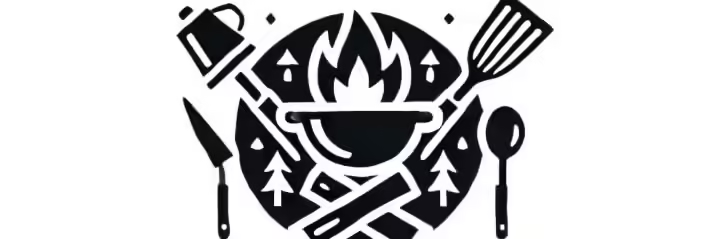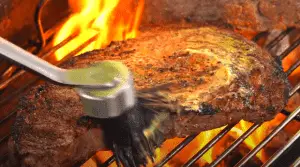Cooking on a grill is more than just cooking; it’s also about creating an experience..
I have spent multiple days enhancing my grilling skills, ultimately I learned that whether grilling or smoking, temperature control is key..
In this “Grilling Temperature Guide,” I am your traveling friend if you pursue grilling mastery. We’ll look at how temperature affects and how well different meats are grilled so that every bite is flavorful…
Here, we’ll learn how to grill food at the ideal temperature for everything from juicy chicken to sizzling steaks. As a result, your backyard barbecue will improve dramatically…
Here I have Included:
- Why Temperature Matters?
- Grilling Doneness Temperature Guide
- The Grilling Temperature Chart
- Tips on Temperature Control
Join me on this adventure, and let’s improve grilling as a whole…;
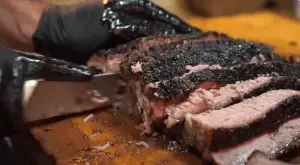
Recommended Reading:
– Gas Grilling vs Charcoal Grilling
– A Step-by-Step Guide for Beginners to Learn the Basics of Grilling.
– Improve Your Grilling Experience
– Outdoor Cooking Tips
# Why Temperature Matters?
Similar to any other skill, grilling demands accuracy. Let’s look at why controlling temperature is essential for grilling success..
Precision is Key
The first thing that comes to mind when picturing a well grilled steak is likely its properly browned outside and its tender, juicy inside.
It takes proper temperature control to execute this level of culinary skill..
Every type of food has a desired temperature range, whether you’re grilling fruit, vegetables or meat (pork, chicken, fish, green beans, yellow squash, baby bella mushrooms, zucchini, red onion or red and orange peppers).
If you go outside of this range, your food may be undercooked, which may be unhealthy, or overcooked and dry..
Texture, Flavor, and Safety
Beyond doneness, temperature also has an impact on texture, flavor, and safety. When your meats are cooked to the right temperature, they’ll be safe to eat and full of flavor and juice.
See our helpful temperature chart to learn how to precisely control the temperature. Whether you like your steak rare, medium-rare, or well-done, use this advice to cook it to the ideal doneness.
Precision is your best friend in the realm of grilling. You’ll be glad you spent the time learning how temperature affects grilling…
# Grilling Doneness Temperature Guide.
| Doneness Levels | Beef Steaks (°F) | Pork Chops (°F) | Chicken Breasts (°F) | Salmon Fillets (°F) | Seafood | Lamb Chops (°F) |
| Rare | 120-125 | 135-140 | 145-150 | 110-120 | 110-120°F | 130-135 |
| Medium Rare | 130-135 | 140-145 | 150-155 | 120-130 | 120-130°F | 140-145 |
| Medium | 140-145 | 145-150 | 160-165 | 130-140 | 125-130°F | 150-155 |
| Medium Well | 150-155 | 155-160 | 165-170 | N/A | 130-135°F | 160-165 |
| Well Done | 160 and above | 165 and above | 170 and above | N/A | 135°F and above | 170 and above |
# The Grilling Temperature Chart.
These temperatures are simple guidelines; use a meat thermometer to ensure exact doneness..
Meat Type-Beef
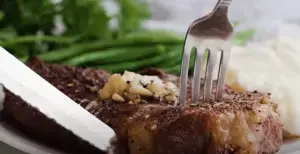
| Meat Type-Beef | Size/Weight | Grill Time (Minutes) | Grill Temperature (°F) | Food Temperature (°F) | Doneness |
| Ribeye Steak | 1 to 1.5 inches thick | 6-8 minutes per side | 130-135 (Rare) to 160 (Medium) | 145-160 (Medium Rare to Medium) | Grill until desired doneness is reached. |
| Filet Mignon | 1.5 inches thick | 4-6 minutes per side | 130-135 (Rare) to 140 (Medium Rare) | 135-140 (Medium Rare) | Grill until desired doneness is reached. |
| T-Bone Steak | 1.25 inches thick | 5-7 minutes per side | 130-135 (Rare) to 145 (Medium Rare) | 135-145 (Medium Rare to Medium) | Grill until desired doneness is reached. |
| Ground Beef (Burgers) | 1/2 to 1 inch thick | 4-5 minutes per side | 160 (Medium) | 160 (Medium) | Cook until the center is no longer pink. |
| Flank Steak | 1 to 1.5 pounds | 6-8 minutes per side | 130-135 (Rare) to 160 (Medium) | 145-160 (Medium Rare to Medium) | Grill until desired doneness is reached. |
| New York Strip Steak | 1 to 1.5 inches thick | 4-5 minutes per side for medium-rare | 450-550 | 130-135 (Medium Rare) | Grill until desired doneness is reached. |
| Brisket | 12-16 pounds (whole brisket) | 12-16 hours using indirect heat at 225-250°F | 225-250 | 195-205 (Minimum for pulled brisket) | Cook until the meat is tender and easily pulled. |
| Short Ribs | Individual ribs | 1.5-2 hours using indirect heat at 225-250°F | 225-250 | 190-205 (Medium to well-done) | Cook until tender and internal temperature is met. |
| Tri-Tip Roast | 2-3 pounds | 25-30 minutes per side for medium-rare | 425-450 | 130-135 (Medium Rare) | Grill until desired doneness is reached. |
| Beef Kabobs with Vegetables | Cubed beef and veggies | 8-10 minutes, turning occasionally | 450-550 | 130-160 (Medium Rare to Medium) | Grill until beef and veggies are cooked to preference. |
| T-Bone Steak | 1 to 1.5 inches thick | 4-5 minutes per side for medium-rare | 450-550 | 130-135 (Medium Rare) | Grill until desired doneness is reached. |
| Sirloin Steak | 1 to 1.5 inches thick | 4-6 minutes per side for medium-rare | 450-550 | 130-135 (Medium Rare) | Grill until desired doneness is reached. |
Meat Type-Pork
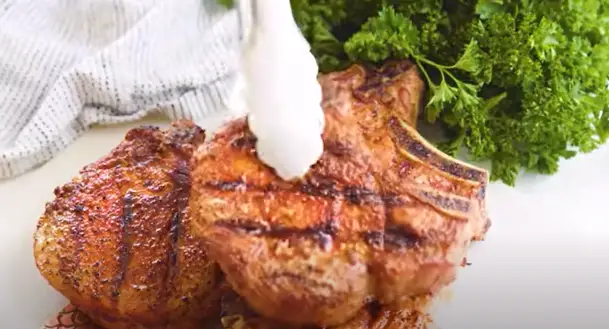
| Meat Type-Pork | Size/Weight | Grill Time (Minutes) | Grill Temperature (°F) | Food Temperature (°F) | Doneness |
| Pork Chops | 1-inch thick | 5-7 minutes per side | 350-450 | 145-160 (Medium Rare to Medium) | Grill until juices run clear. |
| Pork Tenderloin | 1 to 1.5 pounds | 15-20 minutes, turning occasionally | 350-450 | 145-160 (Medium Rare to Medium) | Grill until juices run clear. |
| Pork Ribs (Baby Back or Spare Ribs) | Slabs | 1.5 to 2.5 hours using indirect heat at 225-250°F | 225-250 | 145-160 | Cook until tender; meat should pull easily from the bone. |
| Pork Shoulder (Pulled Pork) | 4-6 pounds | 4-6 hours using indirect heat at 225-250°F | 225-250 | 190-200 (Minimum for pulled pork) | Cook until the meat is tender and can be pulled apart easily. |
Meat Type-Chicken
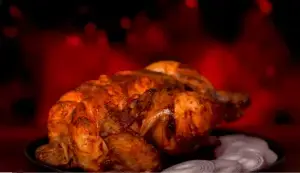
| Meat Type-Chicken | Size/Weight | Grill Time (Minutes) | Grill Temperature (°F) | Food Temperature (°F) | Doneness |
| Chicken Breasts | 6-8 ounces each | 6-8 minutes per side | 350-375 | 165 | Grill until the internal temperature reaches 165°F. |
| Chicken Thighs | 4-6 ounces each | 5-7 minutes per side | 350-375 | 165 | Grill until the internal temperature reaches 165°F. |
| Whole Chicken (Split) | 3-4 pounds | 40-50 minutes, turning occasionally | 350-375 | 165 | Grill until the internal temperature reaches 165°F. |
| Chicken Drumsticks | 2-3 ounces each | 10-12 minutes per side | 350-375 | 165 | Grill until the internal temperature reaches 165°F. |
| Chicken Wings | 2-3 ounces each | 20-25 minutes, turning occasionally | 350-375 | 165 | Grill until the internal temperature reaches 165°F. |
Seafood Type
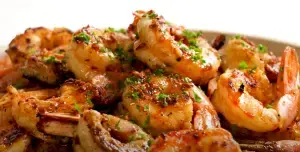
| Seafood Type | Size/Thickness | Grill Time (Minutes) | Grill Temperature (°F) | Food Temperature (°F) | Doneness |
| Salmon Fillets | 1-inch thick | 4-6 minutes per side | 125-130 (Medium Rare) to 145 (Medium) | 145-150 | Grill until desired doneness is reached. |
| Shrimp (Large) | Large shrimp (about 2 oz. each) | 2-3 minutes per side | 350-400 | 145-150 | Grill until they turn pink and opaque. |
| Tuna Steaks | 1-inch thick | 2-3 minutes per side | 350-400 | 125-130 | Grill until desired doneness is reached. |
| Swordfish Steaks | 1-inch thick | 4-5 minutes per side | 350-400 | 125-130 | Grill until desired doneness is reached. |
| Shrimp Skewers | Large shrimp (about 2 oz. each) on skewers | 2-3 minutes per side | 350-400 | 145-150 | Grill until they turn pink and opaque. |
# Different Types of Thermometer
# Tips on How to Control the Temperature
Having the ideal temperature is essential for perfect grilling. The following tips can assist you in obtaining and maintaining precise grilling temperatures:
1. Preheat Your Grill: Start by heating your grill for 10 to 15 minutes with the lid shut. As a result, the grates will be heated and ready for cooking..
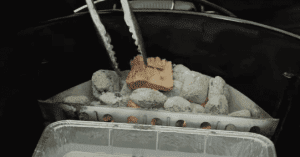
2. Use a Meat Thermometer: Get a reliable meat thermometer.To get an accurate reading, insert it into the thickest part of the meat, avoiding the bone.
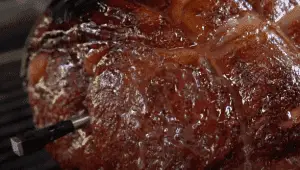
3. Different Cooking Zone: Put different heating zones on your grill. Use one side for direct cooking and the other for high heat. As a result, you have better control over the cooking process.
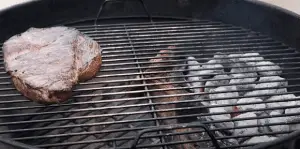
4. Controlling Lids: If you keep the lid closed while cooking, you can maintain a consistent temperature and get that attractive smoky flavor.
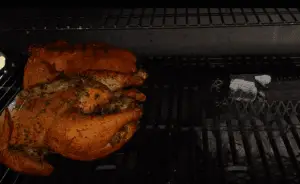
5. Control Flare: Always keep a spray bottle of water nearby to stop flare-ups. With a quick spray, you can prevent food from burning.
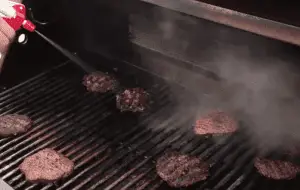
# Videos on how to cook various cuts and methods…to perfection.
# Frequently Asked Question
# How can I cook a lamb chop to perfection on the grill?
For even cooking, grill lamb chops to an internal temperature of 160°F (71°C).There should be no pink color in the center and they should be completely cooked.
# What is the minimum temperature at which seafood such as shrimp and scallops can be cooked?
Seafood, including shrimp and scallops, should be roasted to an internal temperature of 145°F (63°C) to ensure it is safe to eat.
# How can I determine whether my grilled vegetables are done without a thermometer?
Grilled vegetables are done when they are soft and beginning to brown, usually between 8 and 15 minutes depending on the type and thickness.
# What is the ideal grilling temperature for an entire turkey?
Grill a whole turkey until the thickest part of the thigh reaches 165°F (74°C), which will ensure that it is fully cooked and safe to eat.
# How can I maintain a constant grill temperature throughout long cooking sessions?
Follow the guidelines below to keep the temperature of the grill constant..
- Use a thermometer to check temperature.
- Grill should be properly preheated.
- As necessary, adjust the burners or vents.
- Try not to open the grill lid too often.
Conclusion
In summary, improving the art of grilling depends on accuracy and temperature control..
The following fundamental findings are the result of my grilling temperature guide:
The right temperature needs to be maintained for grilling to be successful.This affects the texture, taste, and safety of the food you grill.
Go to the temperature Chart: I have provided a comprehensive temperature chart for all sorts of meat, including beef, pork, chicken, and seafood, as well as various stages of doneness.
Keep this chart in mind when you go grilling in the future.
If you are a beginner or want to become a grill master this chart can help you…
